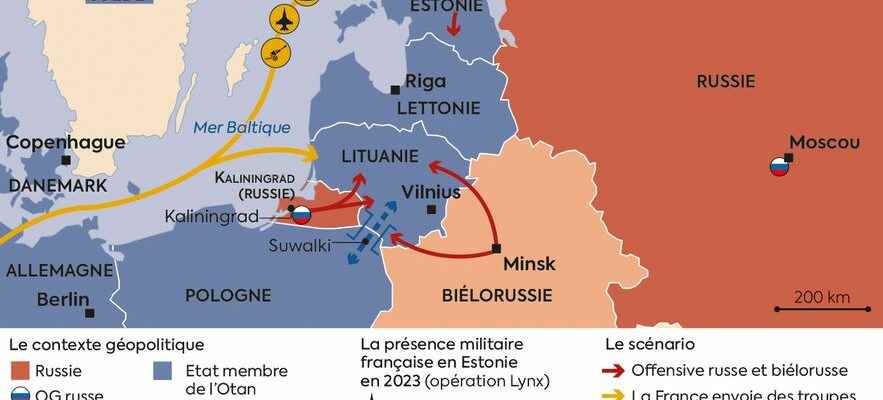In 2013, who could have imagined Daesh, the invasion of Ukraine, the assault on the Capitol? To deal with even the most surprising threats, the Ministry of the Armed Forces has asked the Chiefs of Staff, within the framework of the next military programming law, to detail the dangers hanging over our country. Clearly, to propose credible scenarios justifying the use of force. Independently, L’Express wanted to develop its own “black scenarios” in order to question the preparation, the possible flaws in the French defense, and thus fuel the necessary public debate on these questions at 60 billion euros per year. .
About forty experts – researchers, generals, diplomats, former executives of the DGSE – were asked to deliver their analyzes of the main threats that await France between now and 2030. The framework of these seven scenarios was developed from a real geopolitical tension, to which we have integrated, on the suggestions of our great witnesses, Murphy’s law, himself an American soldier: “Anything that is likely to go wrong will go wrong.” Russia, China, cyber, jihadism… The majority of these hypotheses overlap with those on which the armies are working. These scenarios do not constitute forecasts. The military, considering the worst on principle, are the first to know: it is never certain. Especially if you prepare for it.
Scenario 1: Russia attacks the Baltic countries
March 2026. Russia launched its “special military operation” in Ukrainian territory four years ago and the conflict has still not found its way out. For more than two years, the positions have been stabilized on the front. No ceasefire has been signed but the situation is getting bogged down, to such an extent that a diplomatic agreement is sometimes mentioned by certain European leaders. But this solution is rejected, at all costs, by Ukraine. As Western support cools, anti-NATO propaganda campaigns are being broadcast on social media across the Baltics. “If NATO appears at one time or another to be weak, one can imagine that Russian troll farms are commissioned to hammer home the message that the Alliance is weak and does not really protect the Baltic populations”, points out Yohann Michel, researcher at the International institute for strategic studies.
Captured by disturbing statements by Recep Tayyip Erdogan, the European media show little interest in the reinforcement of Russian forces on the Estonian border. On March 15, Vladimir Putin condemns the repression of the Russian-speaking minority in Estonia. That same evening, Russian tanks and planes entered Estonian territory while several Belarusian battalions, continuously positioned at the border, did the same on the Lithuanian side. this time it is a question of “ensuring the security” of Minsk against the “belligerent impulses of NATO”, declares Alexander Lukashenko, the President of Belarus. “We assume that we will inevitably see Russian troops arrive, because there will be movements at the border. But obviously, they will try to play on the element of surprise”, analyzes General Jean-Paul Paloméros, former chief of the Air Force and ex-Supreme Commander Transformation of NATO.
We are in 2026, and Russia has decided to invade the Baltic countries.
© / Map legends
“The first two or three days will be decisive”
Allied forces positioned in Tapa, Estonia, block the Russian advance at Rakvere, 100 kilometers from Tallinn, the capital. Five French soldiers are killed in the first fighting. Article 5 of NATO is immediately invoked but the United States indicates, through the voice of its Republican President Ron DeSantis, faithful to the isolationist line of Donald Trump, that they will not intervene. “The United States withdrawing would be the real dark scenario for Europe,” worries General Michel Yakovleff, former No. 4 in the NATO chain of command. In the absence of the Americans, it was the French who led the allied coalition. “We would be expected to provide a division [environ 25 000 hommes]“, considers General Yakovleff, who specifies that “the first two or three days will be decisive”.
The geographical situation poses problems for France, far from the theater of operations. “This area is a potential weak point for NATO, because Russia has the Kaliningrad enclave there, while the Suwalki corridor can cut Europe in two if the Russians block access”, notes Zivile Kalibaite, analyst at the Institute for Advanced National Defense Studies.
In the first hours, missiles launched from Kaliningrad hinder the progress of the Allied ships. Alliance aircraft, which arrived in a few minutes, quickly overpowered their opponents, but this advantage was not decisive, given the effectiveness of Russian surface-to-air missiles. On the ground, the NATO army inflicts heavy damage on its counterpart, then begins a counter-offensive on March 22. “The conflict in Ukraine shows that our forces are a priori superior, but we will suffer losses. Is our public opinion prepared for that? Not to mention that we will have to hold out over time,” warns General Yakovleff.
